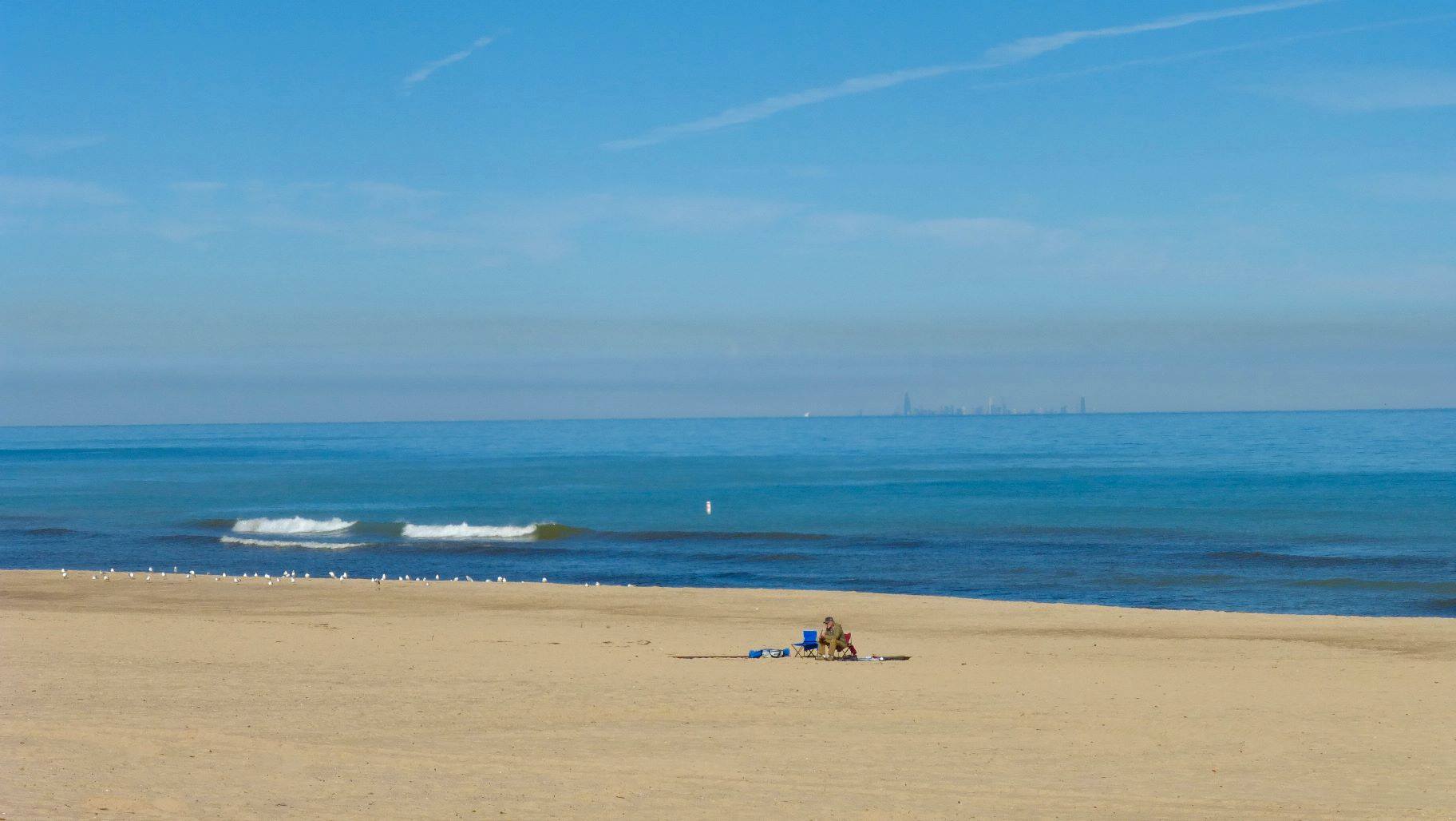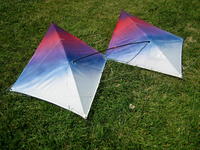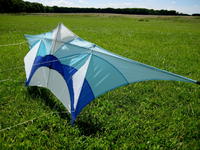-
Posts
3,005 -
Joined
-
Last visited
-
Days Won
60
Content Type
Profiles
Forums
Gallery
Downloads
KL Shop
Blogs
Articles
Everything posted by makatakam
-
The B-Series kites have John Barresi's signature on them. He designed the panel layout and that's why they are called B-Series. The word "standard" refers to the type of sail. The types are: indoor, ultralight, standard, mid vent, full vent, extra vent, and max vent (aka Vickie). Each type is intended to allow comfortable flight within certain wind ranges, from absolutely none all the way through and including gale force. The two that will cover the widest range of wind speed for you, once you have acquired basic control, are standard and full vent. Most folks getting into the hobby start with a standard and subsequently acquire either a full or a mid vent depending on average wind speeds where they will be flying. In other words, the kite "series" whether production models like the SLE and B-Series or custom like the B-Pro Series may be available in any sail type. The SLE, B, and B-Pro are no longer being made, but if you can find them are worth having. The 1.5 classic (1.5 is the size format) currently being produced by Revolution Kites has the Reflex springs that previous versions did not. It has the panel layout of the B-Series but is not a signature kite. Any of the production or custom models may also be available in other size formats, which are 1 (larger than 1.5) and 2 (smaller than 1.5), which may also be available in any series or sail type. If you're looking at what is currently on the GWTW forum, my recommendation is grab whatever you can that fits in your budget. You probably won't find a better deal elsewhere. If I didn't already have a ton of Revs, handles, lines and a Rev bag, I would buy the entire lot myself. The kites being sold are becoming hard to find. I hope that doesn't confuse you. It will become easier to understand as you learn more. It's not rocket science after all, but stunt kites have certainly gained a greater level of sophistication since their introduction. P.S. -- If you have any questions, ask.
-
I believe they encourage flying -- not necessarily on location, but they encourage it.
-
Goodwinds and others have dacron tape readily available. Google kitemaking supplies. It's not expensive and comes in a variety of widths, usually from 1" to 4".
-
Hi, Jake, and welcome to the forum. Get on the GWTW (Gone With The Wind) forum and look in the "kites for sale" section. One of the guys is selling four Revs because of a physical injury that makes it painful to fly kites. I believe two of them are B-Series Revs. Message him and see what he has. Also, they pop up on eBay frequently. You'll need handles, lines and a stake in addition. The stake can be a long screwdriver if you want to keep costs down. I look forward to flying with you someday. Have fun, smile and don't forget to breathe.
-
The only thing I know about big foils is that they have planted me on my face a couple of times, so I'll let the guys with more experience fill you in on what you need to know. I just dropped in to say hi and welcome to the forum. Have fun, smile and don't forget to breathe.
-
You will. If you do you will also learn repair techniques. If you want to keep "lawn dart" damage to a minimum, fly in manageable winds, and run towards the kite when you are about to crash to lessen the impact, or just drop the handles. Most folks' response is to pull which only makes the kite go faster. You will probably crash and break any and all styles of kite with which you are not familiar. Don't worry about it. That's how you learn. Just do what you can to lessen the impact, which will mean that you can't always fly when you want to. Don't push the limits before your skill level can accommodate them. So, if your daughter is not physically impaired, the only advice I can give you is "father knows best". Yes, the big can drag you around, but is a bit slower and therefore easier to learn with. Again, if you don't push the limits until you know what they are you will have no problem. The smaller one is zippier and more fun to fly, but just a tad more difficult to learn with, but foils are super-easy to get the hang of. I'll let you make the call. Simply go with what moves you, what you think will be the most fun.
-
Yeah, that Barresi guy will fly his kite on your grass. Gotta watch out for him. You never know where he'll pop up next. Next thing you know you'll be flying a kite with him and having a cold one after. Run when you see him. He's the kite pusher man. (insert Steppenwolf tune here) You know I smoked a lot of kites, oh Lord I . . . and you won't believe you're on the eve of destruction. Seriously, though, yup that's the one. And he'll fly with you. It's a whole lot easier than getting a game of horse with Michael Jordan, and asking him to help you with your shooting and dribbling. Get comfy, you're family.
-
I saw that in the other post. You made out like a bandit. Enjoy. The Freestylist may need some adjustment. Ask before you fly. Have fun, smile and don't forget to breathe.
-
They do boogie in a good breeze.
-
I could make it happen. Hell, I've already flown one of my Revs as an SLK. (Tails, bow the LE, and three-point bridle)
-
Cool beans. Way to score. Just remember that it is an UltraLight that is more fragile than a standard kite because it is built with lighter materials. If it makes contact with the ground at high speed . . . . well, you get the idea! Mind the wind speed. The Synapse 170 does come with better quality lines, but if your daughter's weakness is the result of physical impairment it may be a bit too much kite for her to handle. Again, mind the wind speed. At 10mph it will pull pretty well. The 140 will fly just fine with the cheaper lines and you can replace them when they eventually begin to wear with better ones. You can also fly it on the lines that come with the Freestylist, assuming he's sending you some. Of course, at that price for that quality of kite I would not complain. A Synapse 140 and a Freestylist for under $50 total is the bargain of a lifetime. Well, it's damn close anyway. Nice catch!
-
Yes, that's exactly why I must resist the temptation. I'm already contemplating turning my Zero G into a dual.
-
Where ya been hiding? Welcome back.
-
I'm basing my opinion, and it's only an opinion because I have not found any facts yet to support it, on quad kites I have built. I my experience any time you have a cross member running across the kite it will create air dams above and below it, which can drastically impede motion in either forward or reverse flight or even both. This is an extreme example of how much it can affect motion. This is an example, only in the horizontal direction. It nearly refuses to side slide. Yes, it's a quad.
-
-
I'm pretty sure the verticals should be in back. The leading edge out in front will allow the area between the verts to billow some, creating more of an airfoil cross section, and not creating air dams on the horizontal to impede forward or reverse motion. If the verts were in front they create scoops toward the ends that would most probably cause instability.
-
You are just plain evil. Go away you evil kite-flying person you. 😃
-
Nope, see the hole in the sail? It's unlikely that it would be there if both LE and verts are on the same side of the sail. I've built a couple of quads where the cross-member went through the sail, similar to a Deca. Perhaps it was designed to offer that flexibility for matching the conditions or different flight characteristics. I'd sure like to get my hands on that sail for a few days. Maybe I'll just build one.
-
Hi, toddnkaya, and welcome to the forum. I look forward to flying with you someday. Figure on spending about $150 for two kites that are of good quality. About $65 for a foil and about $85 for a dual-line stunt kite. Make sure your daughter has her own kite. She will not appreciate waiting for you to finish before she can fly, even if she gets to go first. Visit a kite shop in person if possible for advice and direction. You don't want to start with something that is very difficult to learn to fly. You want to keep it fun, or what's the point, right? Most better quality kites will have ratings on the packaging to let you know if the kite has light, medium or hard pull. Smaller kites have less surface area, therefore less pull, and are faster. Larger kites are slower and more precise, and easier to learn how to control. Small foils zip around pretty good and don't have any hard parts to break when they make fast, sudden contact with the ground, however, all they can really do is fly around in circles and figure-eights. You can get two 1.2 to 1.4 meter foils for about $120 or a bit less. Framed stunt kites are less forgiving when they hit the ground, but allow you to do a bunch of things that a foil can't, by stalling the wing to make the kite do tricks. Start with one that is at least six feet across. You can buy a dual-line kite starting at about $40, but at that price it is toy-grade. The better quality ones start at about $70. You can either mix or match, obviously, so what you start with is up to you. I started with a foil, but within a week had a framed dual as well, and shortly afterwards a quad-line. It can escalate quickly if the bug bites you good. Both you and your daughter should select whatever appeals to you most. Remember, it's all about having fun. Smile, and don't forget to breathe.
-
I always wanted to buy a Horvath glider, but am still afraid that one would only lead to more and I would stray from the true path of my addiction. Can I get an amen!?
-
Hi, Sodog, and welcome to the forum. Where are you located? If you're in the Chicago area, I can give you a hand figuring out how to install that bridle. The bridling should be quite similar to a Rev as far as to which points it attaches. I would be inclined to mount the frame on the back side of the kite, or at least the vertical members in back for some directional stability, like having a keel on each side. At any rate, treat it well. It's definitely a collectors' item. I'm not saying don't fly it, just don't abuse it.
-
Once you get a bit more comfortable with reverse flight it's time to get really comfortable with it. Sit down. On the ground. Yup, plant your butt in the sand or on the grass and fly. It suddenly becomes an entirely different game. You'll feel as out of control as you were on day one two three. Yeah, definitely day three. Learn to fly well while sitting down and you will truly appreciate how easy it is when you're on your feet, and you will understand how moving your feet affects what you can do. It will force precision into your flying. Not only is it fun and like taking a break, but when you can do all the things you can do standing up, you will be well prepared for low wind. It teaches you fine control on inputs, and how important hand position really is.
- 212 replies
-
- 1
-

-
- tips
- san francisco
- (and 4 more)
-
Well done. Now you may proceed to the advanced videos. Feels good to be in complete control and not crashing, doesn't it? You've come a long way since then, and there's so, so, so much more to go. This is the part where the real fun starts. YEEHAW!
- 212 replies
-
- 1
-

-
- tips
- san francisco
- (and 4 more)
-
Yup, the highway thing too. Might even be worse. More "pilots" flying down the road than in the air.
-
Nope. We just ran out of 1950's.

.thumb.jpg.53aabc63a639af8d375b2c92cf2e13f8.jpg)


